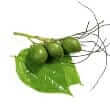Background
- Betel nut use refers to a combination of three ingredients: the nut of the betel palm (Areca catechu), part of the Piper betel vine, and lime. Anecdotal reports have indicated that small doses generally lead to euphoria and increased flow of energy while large doses often result in sedation. Although all three ingredients may contribute to these effects, most experts attribute the psychoactive effects to the alkaloids found in betel nuts.
- Betel nut is reportedly used by a substantial portion of the world's population as a recreational drug due to its stimulant activity. Found originally in tropical southern Asia, betel nut has been introduced to the communities of east Africa, Madagascar, and the West Indies. There is little evidence to support the clinical use of betel nut, but the constituents have demonstrated pharmacological actions. The main active component, the alkaloid arecoline, has potent cholinergic activity.
- Constituents of betel nut are potentially carcinogenic. Long-term use has been associated with oral submucous fibrosis (OSF), pre-cancerous oral lesions (mouth wounds), and squamous cell carcinoma (cancer). Acute effects of betel chewing include worsening of asthma, low blood pressure, and rapid heart beat.
References
Natural Standard developed the above evidence-based information based on a thorough systematic review of the available scientific articles. For comprehensive information about alternative and complementary therapies on the professional level, go to . Selected references are listed below.
- Chitra S, Ashok L, Anand L, et al. Risk factors for esophageal cancer in Coimbatore, southern India: a hospital-based case-control study. Indian J Gastroenterol 2004;23(1):19-21.
View Abstract - Deng JF, Ger J, Tsai WJ, et al. Acute toxicities of betel nut: rare but probably overlooked events. J Toxicol Clin Toxicol 2001;39(4):355-360.
View Abstract - Huang Z, Xiao B, Wang X, et al. Betel nut indulgence as a cause of epilepsy. Seizure. 2003;12(6):406-408.
View Abstract - Jeng JH, Chang MC, Hahn LJ. Role of areca nut in betel quid-associated chemical carcinogenesis: current awareness and future perspectives. Oral Oncol 2001;37(6):477-492.
View Abstract - Kuruppuarachchi KA, Williams SS. Betel use and schizophrenia. Br.J.Psychiatry 2003;182:455.
View Abstract - Lee CN, Jayanthi V, McDonald B, et al. Betel nut and smoking. Are they both protective in ulcerative colitis? A pilot study. Arq Gastroenterol 1996;33(1):3-5.
View Abstract - Liao CT, Chen IH, Chang JT, et al. Lack of correlation of betel nut chewing, tobacco smoking, and alcohol consumption with telomerase activity and the severity of oral cancer. Chang Gung Med J 2003;26(9):637-645.
View Abstract - Mannan N, Boucher BJ, Evans SJ. Increased waist size and weight in relation to consumption of Areca catechu (betel-nut); a risk factor for increased glycaemia in Asians in east London. Br J Nutr 2000;83(3):267-273.
View Abstract - Shiu MN, Chen TH, Chang SH, et al. Risk factors for leukoplakia and malignant transformation to oral carcinoma: a leukoplakia cohort in Taiwan. Br J Cancer 2000;82(11):1871-1874.
View Abstract - Stoopler ET, Parisi E, Sollecito TP. Betel quid-induced oral lichen planus: a case report. Cutis 2003;71(4):307-311.
View Abstract - Sullivan RJ, Andres S, Otto C, et al. The effects of an indigenous muscarinic drug, Betel nut (Areca catechu), on the symptoms of schizophrenia: a longitudinal study in Palau, Micronesia. Am J Psychiatry 2007;164(4):670-673.
View Abstract - Tsai JF, Chuang LY, Jeng JE, et al. Betel quid chewing as a risk factor for hepatocellular carcinoma: a case-control study. Br J Cancer 3-2-2001;84(5):709-713.
View Abstract - Tung TH, Chiu YH, Chen LS, et al. A population-based study of the association between areca nut chewing and type 2 diabetes mellitus in men (Keelung Community-based Integrated Screening programme No. 2). Diabetologia 2004;47(10):1776-1781.
View Abstract - Wu IC, Lu CY, Kuo FC, et al. Interaction between cigarette, alcohol and betel nut use on esophageal cancer risk in Taiwan. Eur J Clin Invest 2006;36(4):236-241.
View Abstract - Yin XM, Peng JY, Gao YJ. [Clinical study on the relationship between tooth abrasion and the habits of chewing betel nut]. Hunan Yi Ke Da Xue Xue Bao 2003;28(2):171-173.
View Abstract







